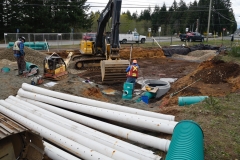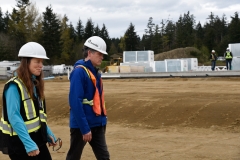If you get drinking water from a private well British Columbia, the provincial government provides no protection from any activities that might foul your water quality. Sylvia Burrosa, the regional hydrologist for the Ministry of Forests, Lands and Natural Resource...

New Courtenay-Comox sewage master plan process to restart after virus lockdown delays
Three short-listed options for new conveyance routes for the Courtenay-Comox sewage system will go to public meetings later this summer
New Courtenay-Comox sewage master plan process to restart after virus lockdown delays
More than a year ago, the Comox-Courtenay Sewer Commission launched a major initiative to develop a new master plan for conveying sewage to the Brent Road treatment plant, as well as envisioning future demand for advanced levels of treatment and the ability to reuse the wastewater and other resources.
The new plan — officially termed a Liquid Waste Management Plan — was designed to address the immediate issue of preventing the failure of the large sewer pipes that run along the beach below the Willemar Bluffs, by moving the entire conveyance system onto an overland route.
Kris La Rose, the Comox Valley Regional District’s senior manager of water and wastewater services, who is leading the project, his staff and a joint Public and Technical Advisory Committee spent more than six months discussing how best to reconfigure the system. At its March 22, 2019 meeting, the committees settled on a recommended short-list of three options, which were then the basis of consultations with the K’omoks First Nation.
It was expected these options, among other recommendations in the new LWMP, would be finalized this summer. But this spring’s COVID-19 virus security measures prevented public consultations planned for May and June.
With the loosening of provincial lockdown requirements, La Rose will seek commission approval next month to resume public consultations during a six-week period starting in August.
And that will push the regional district staff’s final recommendations on conveyance routes and treatment levels to the Courtenay-Comox Sewage Commission into November.
A BACKGROUND REFRESHER
Back in 2014, the sewage commission surprised the public with the now-discarded plan to prevent failure of the Willemar Bluff beach pipe by building a new pump station on Beech Street in the Croteau Beach area, located in Area B, not the Town of Comox.
Croteau Beach residents raised concerns about negative impacts on their groundwater wells and the propriety of forcing sewerage infrastructure on a neighbourhood that neither benefits from it or has a legislative voice on its governance. There was no public input prior to the plan’s announcement.
They also presented an independent financial analysis that showed the regional district had less expensive options.
As planning proceeded, and La Rose was appointed to a new position with authority over the project, it was discovered that the regional district’s original cost estimates were low by at least half and that other red flags had emerged.
La Rose recommended abandoning the original plan for a highly consultative process to develop a long-term plan that would consider a broader range of issues and visions.
The provincial LWMP process recommended by La Rose included forming Technical and Public advisory committees (TAC and PAC), who would also meet jointly and make recommendations with a single voice.
WHAT ARE THE OPTIONS?
The joint TAC-PAC recommendations are for three options.
First, a system to pump sewage directly from the Courtenay No. 1 pump station on Dyke Road over Comox Road hill, through Comox and along Lazo Road to the Brent Road treatment plant.
Second, the advisory committee collapsed three variations of conveying wastewater to the treatment plant via tunnels into one option. In one variation, the sewer pipe would tunnel through Lazo Road hill. In another, it would tunnel through both Comox Road hill and Lazo Road hill. And using a gravity tunnel from Comox to the treatment plant will also be considered. While tunnelling is considered one option, all three tunnelling variations will be studied separately.
Third on the shortlist is to consider the three variations of the tunnelling option but as implemented into two phases.
Earlier this year, the sewage commission unanimously approved the recommendations of its Technical and Public advisory committee.
La Rose says the TAC and PAC committees also recommended three options for treatment levels at the Brent Road treatment plant. They include continuing with secondary treatment, adding filtration for all but peak wet weather flows or filtration for all flows. All three options would include disinfection in the form of UV light.
This article was updated on June 15 to correct the three conveyance route shortlist options.
SUBSCRIBE TO OUR NEWSLETTER
Shocker for homeowners: no protection for private wells
Sewer commission passes on chance to follow own plan
Given yet another opportunity to follow its own Master Plan this week, the Courtenay/Comox Sewer Commission chose to ignore it. Again. A letter from two residents of the Area B neighborhood most affected by the proposed construction of a multi-million dollar pump...
Simply making statements doesn’t mean they are true
Andrew Gower, a partner and branch manager of Wedler Engineering LLP's Courtenay office recently wrote a letter to the editor about the proposed Comox No. 2 pump station. I wrote this letter in response. Neither were printed in the newspaper due to their length, but...
Valley faces a watershed moment
Comox Councillor Barbara Price has offered up misleading statements to defend changes to an antiquated sewerage system that serves only Comox and Courtenay residents. Price chairs the Comox Valley Sewage Commission, which is itself a misnomer. The Sewage Commission...
Director calls for Valley-wide sewer plan
When elected officials and the community they represent achieve a certain level of synchronicity, good governance and good outcomes usually result. So a reasonable person might expect that after voters strongly rejected a Comox Valley Regional District sewerage system...
How will the CVRD respond to failed sewer referendum?
When Royston and Union Bay voters overwhelmingly rejected the South Sewer Project on Saturday, they added their voices to a broadening concern about the Comox Valley Regional District’s sewerage strategy. Consider: Some years ago, residents of the Saratoga-Miracle...
Quadra sewer project upsets citizens at public meeting
A crowd of roughly 75 citizens peppered Comox Valley Regional District Senior Engineer Marc Rutten Jan. 17 with questions and angry statements at an open house about the HMCS Sewer Project. At times the meeting threatened to spin out of control as residents shouted...
Small number of voters will have large, long-term effect
Many residents of Royston and Union Bay will vote tomorrow on whether to fund a new sewerage system to service their communities. This seemingly isolated decision will have a profound and long-term impact on the entire Comox Valley. If voters approve this referendum,...
Proposed South Sewer pipe to take harmful route
Advance voting is underway for the June 18 referendum when Royston and Union Bay voters will decide whether to tax themselves to build and connect to a community wastewater system. To clear up some of the misinformation about this Comox Valley Regional District...
Vote “no” in the South Sewer System referendum
Prime Minister Justin Trudeau recently said that “governments can grant permits, but only the community can grant permissions.” It’s a message that has inspired Canadians, but one that has fallen on deaf ears at the Comox Valley Regional District. Residents from all...


 Comox shellfish contaminated
Comox shellfish contaminated
 That got laughs from Grant and Comox Director Maureen Swift, but the Courtenay directors didn’t appear to find it amusing.
That got laughs from Grant and Comox Director Maureen Swift, but the Courtenay directors didn’t appear to find it amusing.







